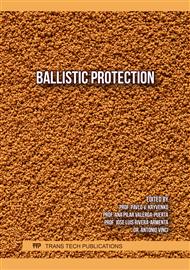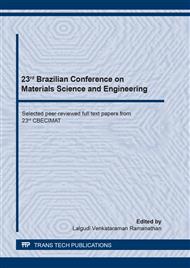p.173
p.179
p.185
p.190
p.196
p.202
p.207
p.215
p.221
Novel Alumina Compounds with Niobia, Silica and Magnesia for Ballistic Armor
Abstract:
Compounds of alumina APC-2011 SG with niobia, silica and magnesia were sintered at 1400°C/3h, in order to evaluate their ballistic performance. The content of niobia (Nb2O5) was 4.0 to 8.0 wt.%; silica (SiO2) was 0.8 wt.%; and magnesia (MgO) at 0.15 wt.%. Sintered samples were characterized by hardness, densification and energy absorption at impact. Ballistic tests were performed by ceramic discs firmly glued to steel plates and then subjecting the target to impact using 7.62 mm projectile shot from a rifle with a throw distance of 5 m. The energy absorbed by the disintegration of the ceramic discs was estimated by the residual velocity. The fracture surfaces of the samples were observed by scanning electron microscopy. It was verified for the first that the addition of high amounts of Nb2O5 to the alumina with the presence of SiO2 and MgO increases the presence of vitreous phase in the contours of alumina grains and improved the properties of the material for use in ballistic protection.
Info:
Periodical:
Pages:
196-201
Citation:
Online since:
October 2020
Keywords:
Price:
Сopyright:
© 2020 Trans Tech Publications Ltd. All Rights Reserved
Share:
Citation:



